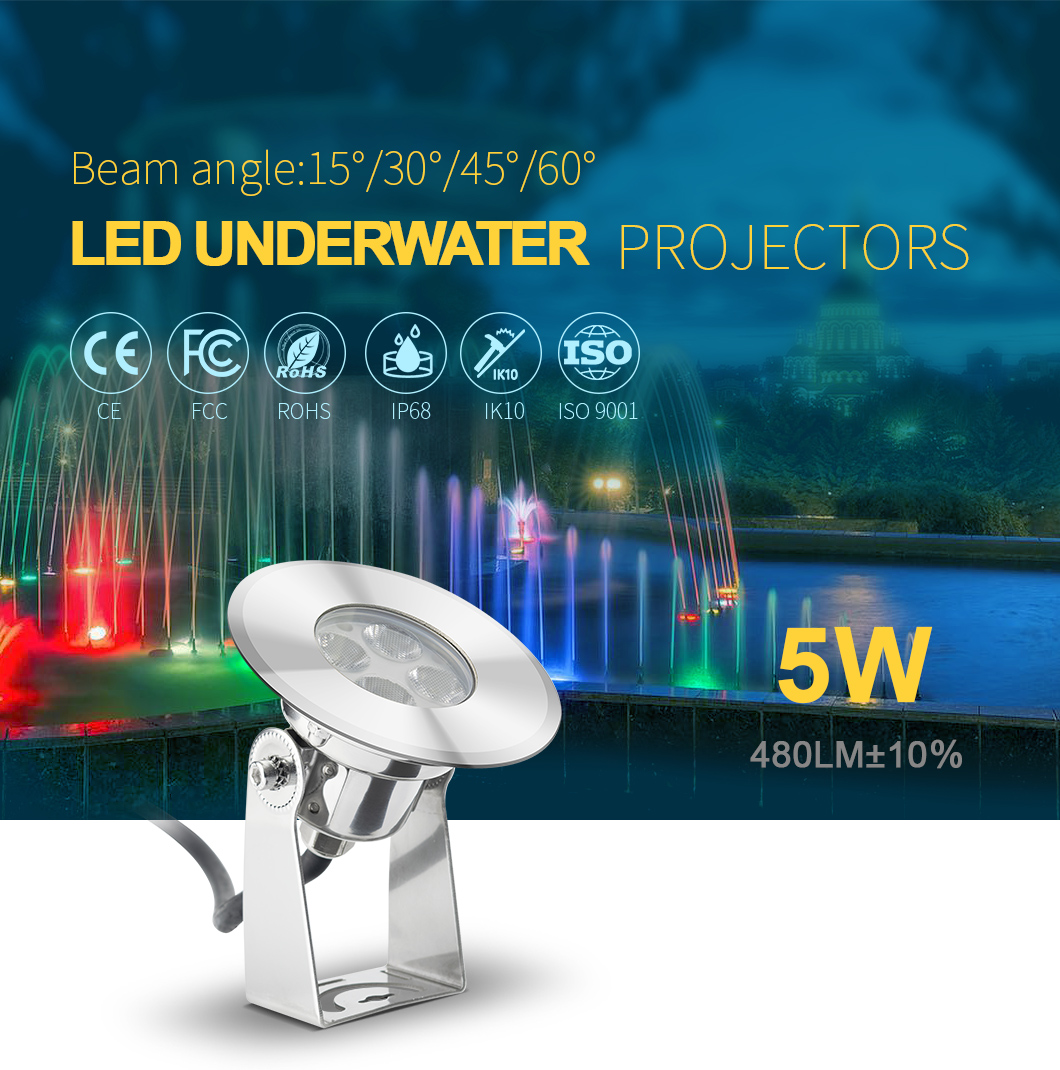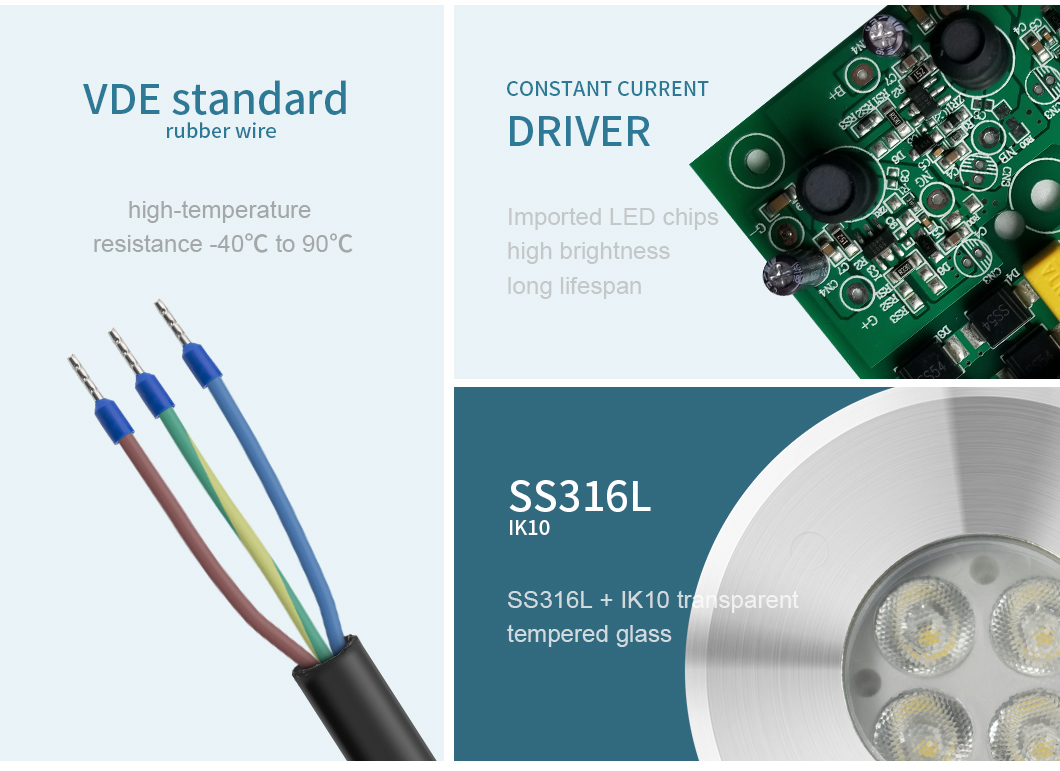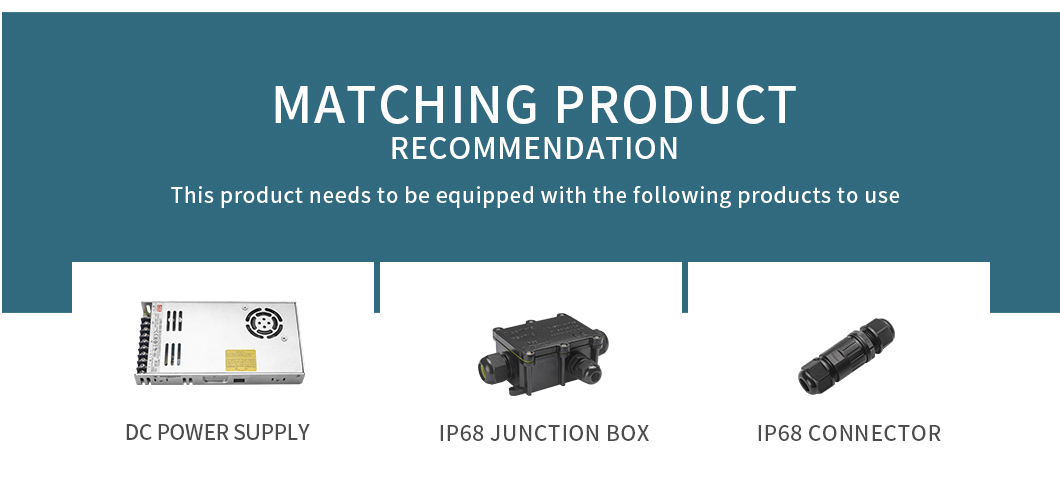5W 316L stainless steel white underwater lights
white underwater lights Features
1. Utilizes daylight-grade white LEDs with a CRI ≥ 95, closely reproducing the natural spectrum and accurately reproducing water color, swimmer skin tone, and pool wall details.
2. Seamless dual-mode color temperature switching allows a single light to meet diverse scenarios, supporting intelligent color temperature adjustment from 2700K to 6500K.
3. Micron-level hydrophobic anti-algae coating on the lampshade effectively inhibits scale and algae adhesion, preventing light degradation caused by dirt accumulation.
4. Adaptive brightness adjustment technology balances energy efficiency and safety.
white underwater lights Parameters:
|
Model |
HG-UL-5W-SMD |
|
|
Electrical |
Voltage |
DC24V |
|
Current |
210ma |
|
|
Wattage |
5W±1W |
|
|
Optical |
LED chip |
SMD3030LED(CREE) |
|
LED (PCS) |
4PCS |
|
|
CCT |
6500K±10%/4300K±10%/3000K±10% |
|
|
LUMEN |
450LM±10% |
|
1. What are the advantages of white underwater lights over colored lights?
- Enhanced Visibility: White light provides superior illumination for swimming, maintenance, and safety monitoring.
- True Color Rendering: High CRI (≥90) options accurately reveal pool details, water clarity, and swimmers’ features.
- Multi-Purpose Use: Ideal for functional lighting (e.g., lap swimming) and ambiance (e.g., warm white for relaxation).
2. Can white underwater lights be used in saltwater pools?
Yes, but ensure:
- Corrosion-Resistant Materials: Housing and screws should be 316 stainless steel or titanium.
- IP68/IP69K Certification: Protects against saltwater corrosion and high-pressure cleaning.
- Sealed Connectors: Use waterproof junction boxes and corrosion-proof cable glands.
3. How do I choose the right color temperature for my pool?
| Color Temperature | Best For | Effect |
|---|---|---|
| 2700K-3500K (Warm White) | Residential pools, spas | Creates a cozy, inviting atmosphere |
| 4000K-5000K (Neutral White) | All-purpose lighting | Balanced visibility and comfort |
| 5500K-6500K (Cool White) | Commercial pools, security | Maximizes brightness and alertness |
4. What maintenance do white underwater lights require?
- Monthly: Wipe lenses with a soft cloth and vinegar solution to remove mineral deposits.
- Annually: Check seals and O-rings for wear; replace if cracked or stiff.
- As Needed: Inspect for algae growth or debris blocking light output.
5. Are white LED lights harmful to aquatic life?
Not typically, but:
- Avoid excessive brightness in natural bodies of water to prevent disturbing ecosystems.
- Use shielded fixtures to direct light away from sensitive areas (e.g., fish nesting zones).
- For ponds/aquariums, opt for lights with adjustable intensity to mimic natural day/night cycles.
6. Can I replace my old halogen lights with white LED lights?
Yes, and you’ll gain:
- Energy Savings: LEDs use 80% less power than halogen equivalents.
- Longer Lifespan: 50,000 hours vs. 2,000 hours for halogen bulbs.
- Cooler Operation: Reduced heat prevents overheating risks.
Note: Verify voltage compatibility (12V/24V vs. 120V) and fixture size before purchasing.
7. Why is my white light appearing blue or yellow?
- Blue Tint: Often caused by low-quality LEDs with poor color rendering. Choose high-CRI (>90) lights.
- Yellow Tint: May indicate aging LEDs or incorrect color temperature selection.
- Solution: Select reputable brands with consistent color temperature ratings.
8. How many white lights do I need for my pool?
- Small Pools (<30㎡): 2-4 lights (e.g., 15W-30W each).
- Large Pools (>50㎡): 6+ lights spaced 3-5 meters apart.
- Tip: For uniform lighting, install lights on opposite walls and avoid placing them near seating areas to reduce glare.
9. Do white underwater lights work with smart home systems?
Yes, many modern options support:
- Wi-Fi/Bluetooth Control: Adjust brightness/color temperature via smartphone apps.
- Voice Commands: Compatible with Alexa, Google Assistant, or Siri.
- Automation: Schedule on/off times or sync with other outdoor lighting.
10. What should I do if my light fails or fogs up?
- Fogging: Indicates a broken seal. Turn off power, dry the fixture, and replace the O-ring.
- No Power: Check connections, transformer, and circuit breaker. Ensure GFCI protection is functional.
- Flickering: Often due to voltage fluctuations or a failing driver. Consult a professional for diagnosis.














